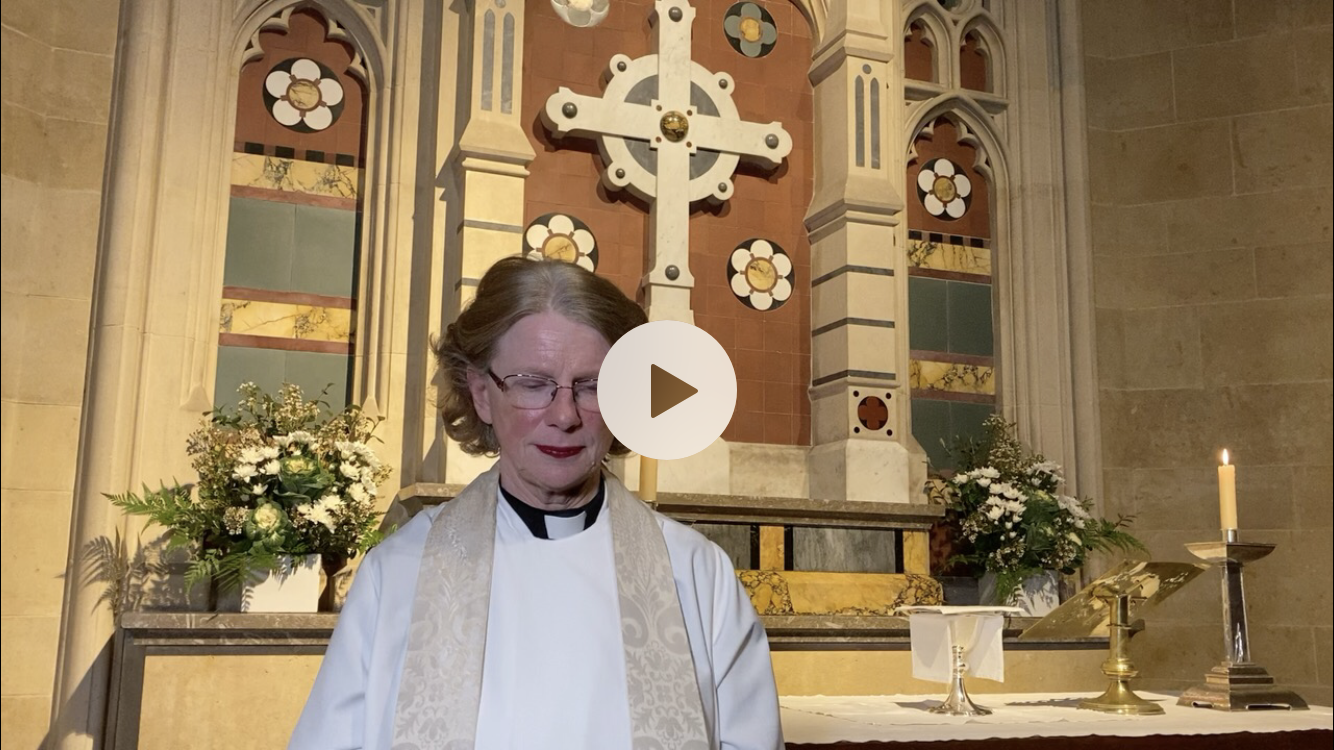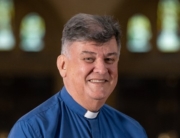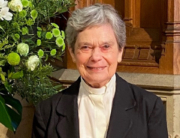A sermon by The Rev’d Canon Jenny Wilson
In the name of God, creating, redeeming, sanctifying, … Amen.
There is a staircase in our Cathedral, a staircase made from scaffolding. Ascending this scaffold staircase, after a number of layers, we find ourselves at the first platform, a platform from which one can see down into the pipes of our newly restored organ and down onto the top of the reredos. That’s how high it is but here is further to go. Layer after layer of staircase, until we reach the second platform, the platform from which we can see what we might think of as the God view. We can look through a rose shape in the stone nearing the cathedral lantern and through this rose shape we can see below us, far below, the nave floor. The tiled floor that welcomes and holds and keeps watch over all who enter the Cathedral doors. Here, through the rose of stone high up on this scaffold is the God view, the Father’s view, the Creator’s view, looking down, seeing all that God has made. “Our Father in heaven,” don’t we say? “To you I lift my eyes, you that our enthroned in heaven,” the psalmist says in Psalm 123. Or, in our reading from the Book of Exodus this morning, we hear of God descending in a cloud and speaking with Moses on a mountain. The image of the Father, the creator, God, high above the earth looking down.
God sees. That is what matters. And longs that we should know. And so there is the Son, the Word, God’s self-communication, the sacrament that helps us know who God is and how we are loved and forgiven. Jesus. It is tempting to push our scaffold analogy and to imagine Jesus coming down that scaffold staircase. “Love came down at Christmas,” don’t we say, or sing? But it was not like that. Jesus came and walked the earth through the fierce courage and determined faith of his mother Mary. The incarnation was not an afterthought, by the way. God did not create, and seeing what humankind wrought, decide a rescue mission was needed. No, the incarnation was woven in from the start. “In the beginning was the Word,” the writer of the Gospel of John has his beginning; “the Word became flesh and dwelt among us, full of grace and truth.” Walking the tiled floor of our cathedral, accompanying all who go there. We might imagine there on that floor all about the world that is held in our thoughts at this time. A virus that has captured us and changed all our lives, those who have died of this caronavirus, and those who bravely care for them, those who grieve the loss of loved ones and livelihoods and the normal lives that we only know as treasure once it is taken away. Those scientists searching for treatments and vaccines. What else walks our nave floor … the violence in America, a man we had not known but whose name is now on all our lips, George Floyd, brutally murdered by those who are employed and entrusted with our protection? And leaders who fail so dismally to love and protect and inspire, and not just the leaders but those around them who do not stand up, do not speak out, clinging to their little powers when at times we need them to risk everything and speak the truth.
Jesus, the Son, the Word, came and walked this earth, kept company with all of this, and taught and healed and freed us from fear and all that stops us knowing that we are meant to thrive, made by God to thrive. Jesus the Son whose death and resurrection brought redemption to the creation made by God.
And what of the Holy Spirit? It is tempting to think of the scaffold staircase as the Holy Spirit, the link between the place of God and the earth we glimpse as our tiled nave floor but we might be careful about that. I once read a book about the Holy Spirit called “The Go-Between God[1]” and I remember going to the fine theologian, Denis Edwards, who taught many of us about the Trinity at theological college, with all the enthusiasm that students have, saying “Is the Holy Spirit like this? A go-between?” I thought I understood it, you see. “Is the Holy Spirit like this?” Then, with all the compassion and gentleness that a wise teacher has for their student, that a spiritual director has for the one who comes to them longing to know the ways of God, Denis Edwards said to me, “Well … Not really.”
What shall we say of the Spirit then? We heard the story of the coming of the Holy Spirit last week at Pentecost of a rushing wind and tongues of fire and of people who heard for the first time the truth of Jesus and all his life and death meant. John’s Gospel tells the story differently with Jesus in the upper room speaking words of peace and then breathing on them saying “Receive the Holy Spirit,” a spirit he clearly deeply connected with forgiveness[2]. One hymn that seems to me to have words that are deeply insightful about the spirit is written by John Bell of the Iona community. He calls the Holy Spirit the “enemy of apathy”. “She sits like a bird, brooding on the waters, hovering on the chaos of the world’s first day, she sighs and she sings mothering creation…” No doubt again that the spirit was there right from before the dawn of time. Enemy of apathy … insight into the spirit … I wonder …
Yes, it is Trinity Sunday, and as we do each year, we spend a little time this Sunday pondering the nature of God. We have journeyed through Lent and Holy Week, through Good Friday and the season of Easter, through Ascension tide and the Feast of Pentecost, this year in such a strange way. Deprived of gathering together on that nave floor upon which God gazes, deprived of watching and singing and holding out our hands for the love of God that we know in the sacrament of Holy Communion, we have worshipped none the less, known in different ways God’s love and our connection with our beloved community … at home. And now we ponder, still at home, the nature of God. Is God like this? A father, creator, gazing through a rose in stone at a tiled nave floor below? A Son walking that floor with us? The Holy Spirit breathed on us by that Son to help us know, now especially now, that God sees, loves …Is God like this? “Not really?” The theologian Denis Edwards, who died last year, might have said. “Well, maybe a little like this …”
John Donne wrote at the time of a plague and he thought he might die in it. He pondered that great truth that is woven into all finite life. I wonder if we might find an image for God and God’s beloved creation in his words. I am indebted to the new Dean of Westminster Abbey who in a recent podcast[3] quoted John Donne:
“All mankind is of one author, and is one volume; when one man dies, one chapter is not torn out of the book, but translated into a better language; and every chapter must be so translated. God employs several translators. Some pieces are translated by age, some by sickness, some by war, some by justice. But God’s hand is in every translation and his hand shall bind up all our scattered leaves again.”[4]
Leaves in a book perhaps? Yes, we belong in a story. Is God the author of the story, the binder of the leaves of the story, the one who reads the book? Is God like this? “No. Not really. Well … maybe a little like this.”
Time to let go of trying to understand for this year, don’t you think? Time to return to the story? Time for our sacristan to change the altar frontal to green and get out the green robes. For ordinary time begins again next Sunday. We will tell the story through Matthew’s eyes and ears. We will find ourselves there and all our world. We will find healing and forgiveness and love there. And a place to tell all our fears and all our regrets and all our hopes. We will find God there. Or, perhaps, it would be a little closer to the truth to say … God will find us.
[1] John V Taylor
[2] John 20:19-23
[3] Westminster Abbey Podcast 75th Anniversary of VE Day
[4] John Donne Meditation 17




